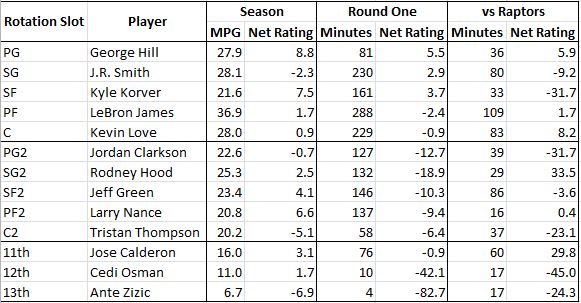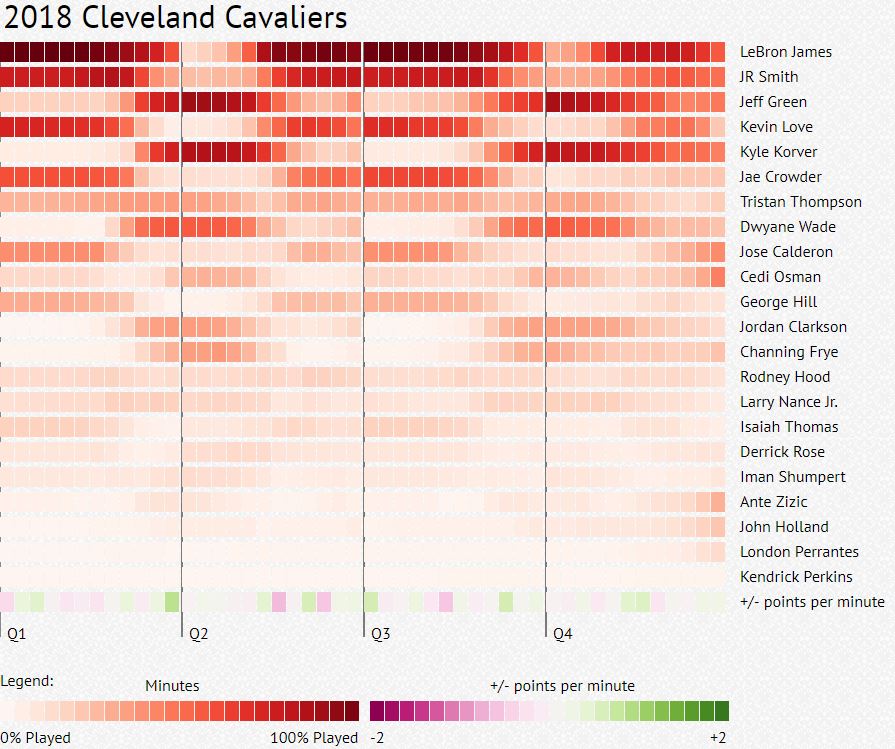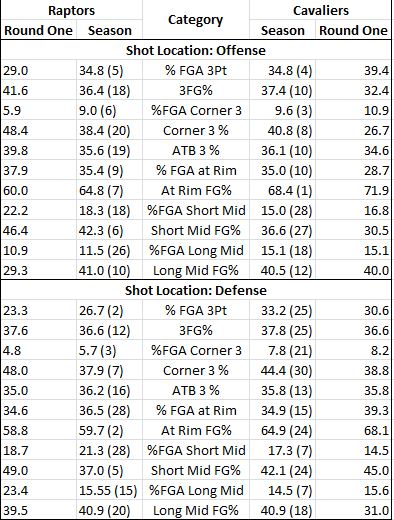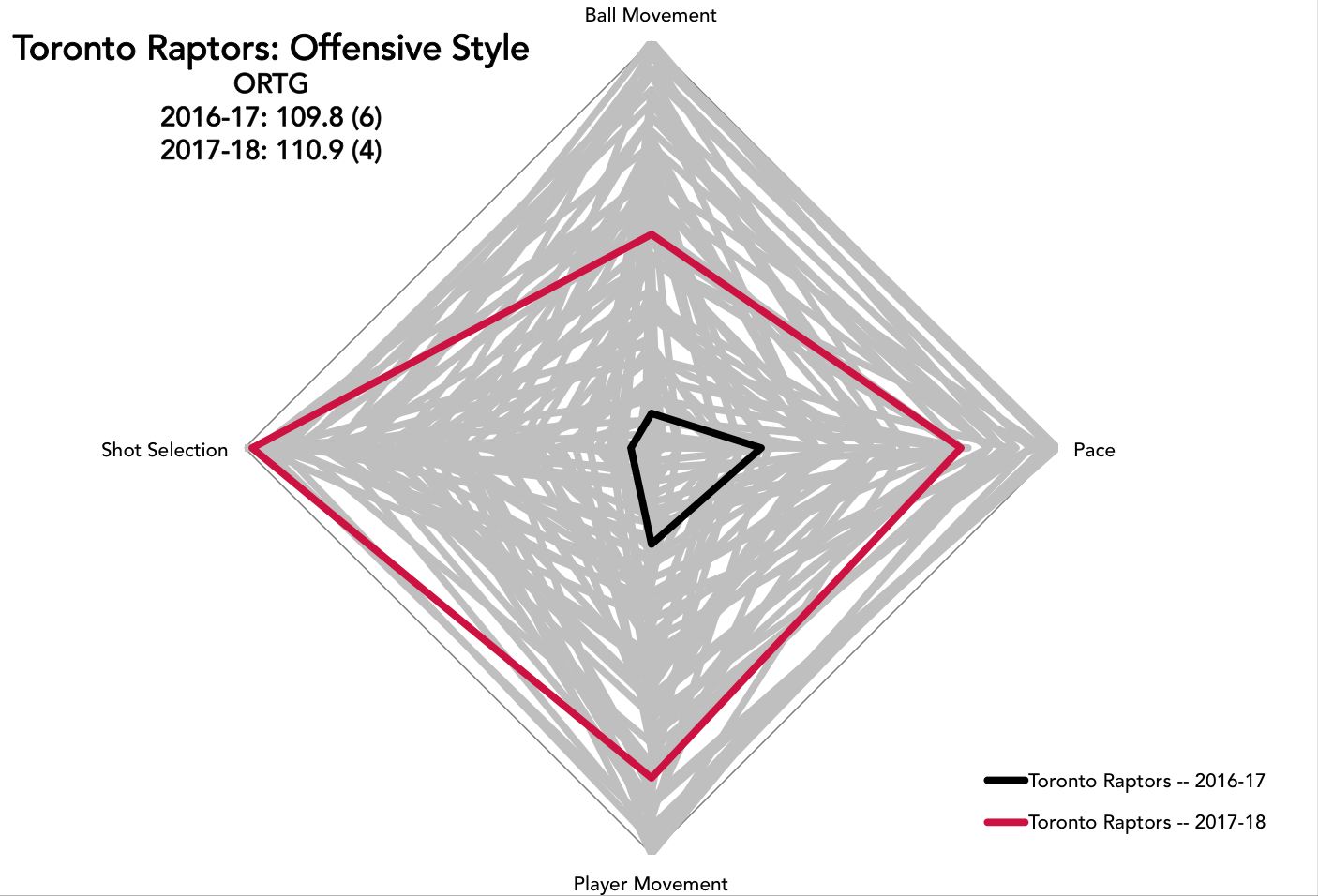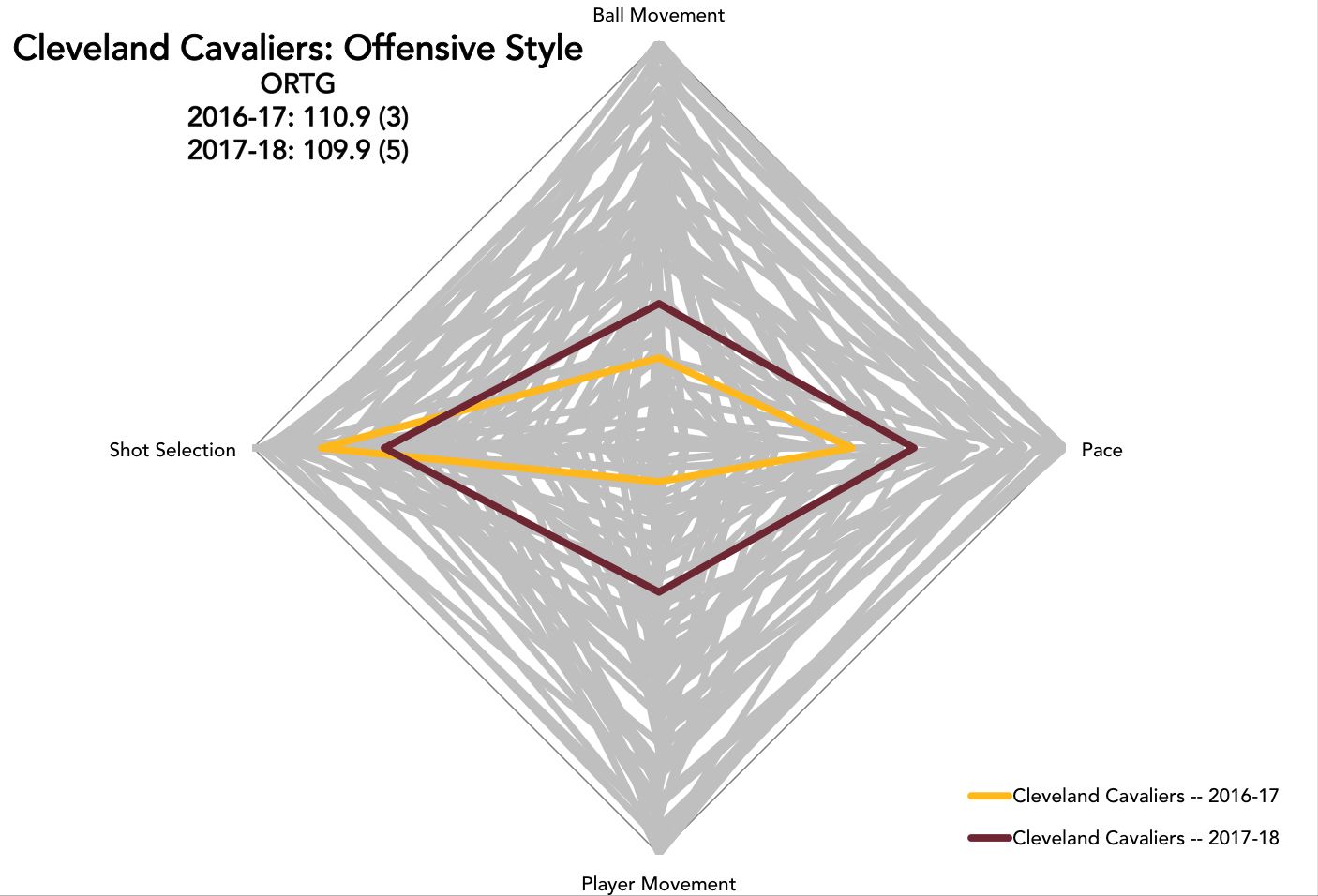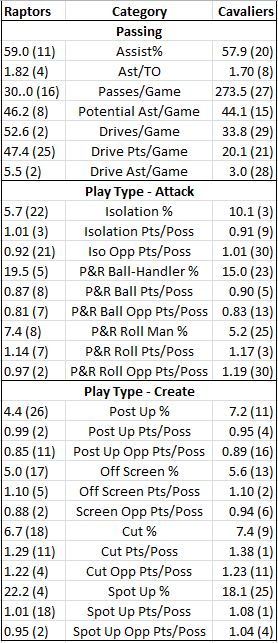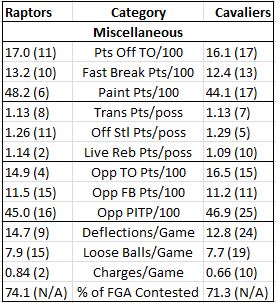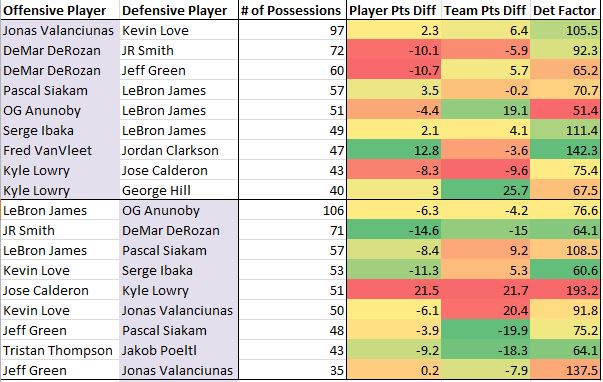For a third postseason in a row, the Toronto Raptors will play the Cleveland Cavaliers. To help us get started on our preview content, what follows is a high-level data dive to get a snapshot of each team over the course of the season. Unfortunately, a lot of it is not particularly useful. The Cavaliers remade themselves mid-season, rarely played healthy, rotated through a number of starting lineup and rotation looks (even just in the first round), and the three games between the teams were not incredibly prescriptive, given availability and fatigue. There’s also the specter of LeBron James rendering team-wide data moot, as he did four times against the Indiana Pacers. Still, we try.
All of this is strictly descriptive, and obviously the caveats laid out (and more) need to be considered. Dwane Casey and Ty Lue will tweak their base strategies for the opponent, personnel may dictate rotation tweaks, and, as always in a short-ish seven-game series, there will be ample room for variance. Oh, that sweet, horrifying shooting variance. Consider this just a first sweep of how the two teams performed during the regular season.
Schedule
Rotations & Lineups
Toronto: Everyone has a good idea of what to expect from the Raptors by now. They run 10 deep, will comfortably play two more as the situation calls for it, and their all-bench unit and starting lineup were two of the most successful groups in the league. Fred VanVleet missing four games (five, really) in the first round threw that for a loop, with Norman Powell and Lorenzo Brown being called on and Kyle Lowry and Delon Wright being extended, but once VanVleet returned, the rotation felt remarkably familiar once again. Powell still looms if the team needs a defensive spark, and basketball knuckleballer Lucas Nogueira is around in case of foul trouble or a break-glass-for-entropy situation. Here’s a quick look at how the Raptors fared individually this year, against the Wizards in round one, and in three games against the Cavaliers.
And here’s a look at how the Raptors’ rotations played out this year, per NBARotations.info:
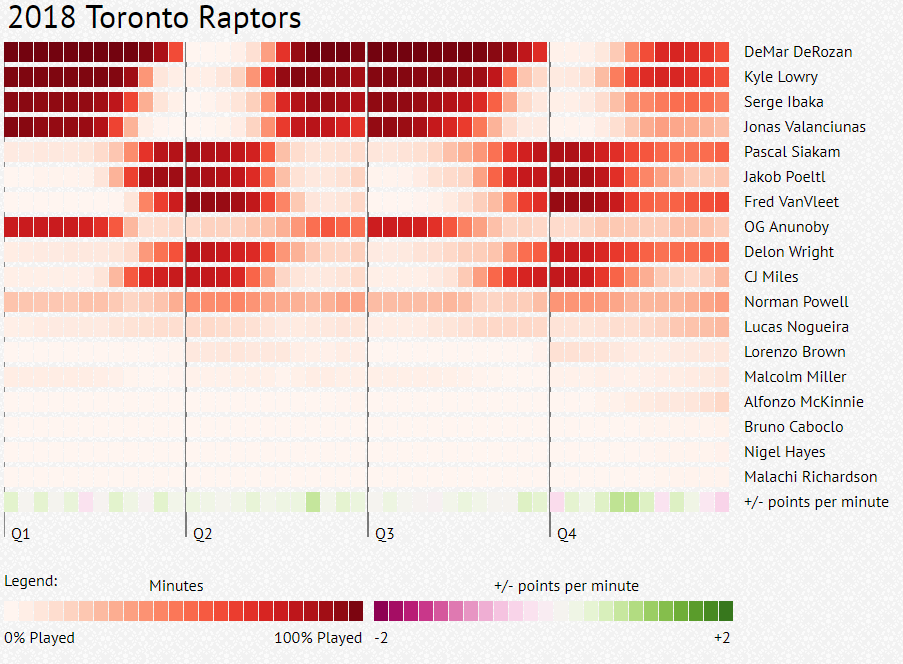 Cleveland: I mean, who the hell knows? The Cavaliers used 22 different players this year, as well as 29 different starting lineups – and four in the first round alone – none of which started more than seven games together and are available to them here. They are still, in late April, figuring things out, and that makes them a little hard to peg down. It also makes their data sample incredibly noisy. I was really unsure on how to even structure this depth chart, because it could be any 10 of the top 12 guys on a given night and any number of starting lineups. The initial guess here is they start small, but there’s going to be a lot of mixing and matching and tweaking, especially if they don’t want their bench to get pasted. Here’s a quick look at how the Cavaliers fared individually this year, in round one, and against the Raptors:
Cleveland: I mean, who the hell knows? The Cavaliers used 22 different players this year, as well as 29 different starting lineups – and four in the first round alone – none of which started more than seven games together and are available to them here. They are still, in late April, figuring things out, and that makes them a little hard to peg down. It also makes their data sample incredibly noisy. I was really unsure on how to even structure this depth chart, because it could be any 10 of the top 12 guys on a given night and any number of starting lineups. The initial guess here is they start small, but there’s going to be a lot of mixing and matching and tweaking, especially if they don’t want their bench to get pasted. Here’s a quick look at how the Cavaliers fared individually this year, in round one, and against the Raptors:
And here’s a look at how the Cavaliers rotations played out this year:
Overall Performance
There’s not a whole lot to say here that doesn’t come with applicable, King-sized caveats. The Raptors were better than the Cavaliers in nearly every respect, significantly so in many. They were the only team in the league to finish in the top five on both ends of the floor, their offense held up in the first round for a change, and despite being the second-youngest playoff team by average roster age, they may also be the deepest. The Cavaliers, meanwhile, were terrible defensively for the bulk of the season, occasionally flashed a crunch-time ability to lock in when it mattered, at least for a few possessions, and generally carry an air that when James chooses, he can drag them higher.
So, yeah, it’s a dangerous team. They have the best player in basketball, and he just turned in a ridiculous series – including an incredible and exhausted Game 7 for the ages – that showed he can bet a good team even when the players around him aren’t shooting well. And if they begin shooting well, like the Raptors saw in the playoffs last year or their two earlier meetings this season? The Raptors could be in for a shootout. They’re equipped for that now, but it’s still not their preferred style of play. It’s probably worth remembering, too, that despite the narratives around them, the Cavaliers still won 50 games. They found a way.
(League rank in parentheses, per NBA.com.)
Shot Spectrums
A huge focus for the Raptors all year on the offensive end has been changing their shot selection such that threes are valued more heavily and low-efficiency mid-range shots fall to the wayside. They’ve largely accomplished that, with only DeMar DeRozan and Serge Ibaka shooting from the high mid-range with any frequency and the team ratcheting up their 3-point volume as a team. They even cut down their long mid-range shots further in round one, though they did take a few more of the “short mid-range” or “floater range” shots that the Wizards’ defense offered up. The Cavs defense cares far less about which shots an offense takes. Their most potent lineups are devoid of rim protection, and their trapping scheme opens up 3-point opportunities – Cleveland allowed a top-ten rate of shots from either 3-point location, and opponents shot above the league median from every spot on the floor except (slightly) above-the-break threes.
(Shot charts via AustinClemens.com.)
The other end of the floor is far more intriguing, because the Cavaliers can do a lot of damage from beyond the arc if an opponent dares them. Cleveland was near the bottom of the league in mid-range shot attempts and were third in volume of corner threes (with a top-10 3-point percentage), showing in just one stat the danger of loading up and sending too much help at James. The Cavs also had the league’s best field-goal percentage at the rim, which is to be expected if you don’t send the help. So, it’s a tough Sophie’s Choice there. The Raptors tweaked their scheme this year to send less help to pick-and-rolls in general, really only helping with any frequency on post mis-matches. That strategy aimed to invite more mid-range shots, shots that Cleveland doesn’t take a lot of but has shown in the last two meetings its capable of hitting. The tough choice James forces at least tilts a little bit toward staying at home on shooters and forcing James to turn in Herculean efforts.
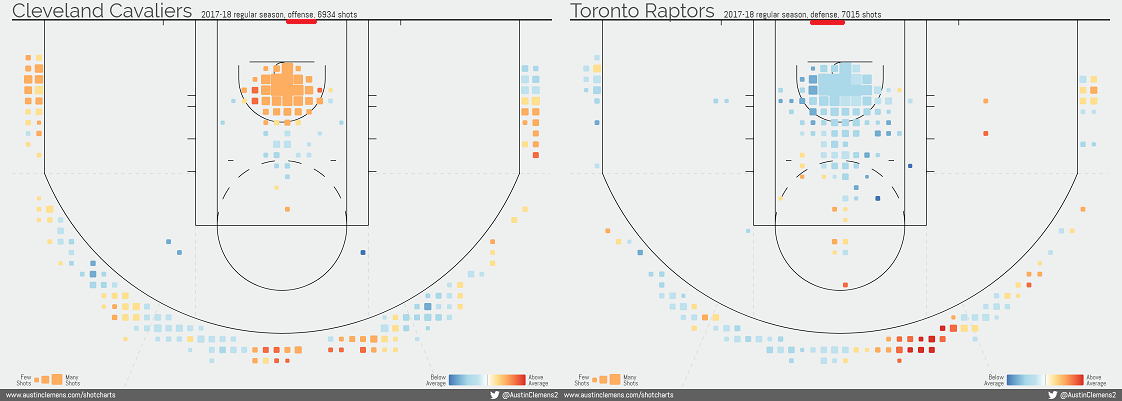 Again, it’s worth noting that season-long numbers are a little messy here with all of Cleveland’s turnover. Indiana proved a reasonably helpful litmus test of their playoff offense – again, with injury caveats – as the Pacers were a fairly moderate defensive team outside of a strong willingness to give up above-the-break threes. Looking the other way, oh boy do the Cavs surrender some good looks from outside.
Again, it’s worth noting that season-long numbers are a little messy here with all of Cleveland’s turnover. Indiana proved a reasonably helpful litmus test of their playoff offense – again, with injury caveats – as the Pacers were a fairly moderate defensive team outside of a strong willingness to give up above-the-break threes. Looking the other way, oh boy do the Cavs surrender some good looks from outside.
(League rank in parentheses, per CleaningTheGlass.com.)
Playing Style
There has been no better capture of the Raptors’ drastic shift in playing style than this chart from Ian Levy at Nylon Calculus, displaying the change in pace, ball movement, and improved shot selection. This is a dramatically different Raptors team:
The Cavaliers have changed far less from last year, speeding up their pace just a bit and injecting some ball- and player-movement, and taking slightly worse shots overall. This is still very much a team built to leverage the attention James draws by surrounding him with shooters, those shooters are just doing a bit more to get open this time around.
The Raptors’ reliance on isolation in the past was always a little overstated, and they’re safely in the bottom 10 for isolation frequency now, even though they’re still among the best scoring through those means. Instead, Toronto leans heavily on the pick-and-roll, ranking in the top 10 in frequency and efficacy for both the ball-handler and roll-man (they’re also in the top 10 defending each). Toronto’s post-up diet consists mostly of improvised looks out of other actions, and the removal of clear-it-out dump-ins has helped Toronto become one of the best post-up teams in the league when they do use them. The Raptors still drive to the rim more than almost anyone, too, they’re just looking to pass out of those drives a little more often rather than getting right to the rim or to the line. In the post-season, the Raptors isolated even less frequently, subsisting more off of cuts and screens. It’s notable that their pick-and-roll attack was far better against Washington when Jonas Valanciunas was the screener compared to any other big. Defensively, Toronto doesn’t have a clear play-type weakness, though they’re a little below average guarding in isolation. This is a pretty well-balanced attack on both sides of the ball.
Conversely, the Cavaliers are an interesting isolation team snapshot. They isolate with the third highest regularity and are the league’s worst defense defending in isolation. What’s more, their isolation rate went through the roof in the first round, with James running a ludicrous 60 isolations, per NBA.com (Synergy data apparently shows even more ISOs). Those are very tough to stop, but they also seemed to keep Cleveland’s role players out of rhythm. James had to go supernova four times against a team that doesn’t have the offensive ceiling to punish their shortcomings the way Toronto does. And that note earlier about Valanciunas as a screener? The Cavs were the league’s worst team defending against roll men. There’s an obvious trade-off in that matchup, one the Raptors might be able to tilt their way by shifting a few extra possessions to a barreling Valanciunas through the paint. It’s quite notable how high Cleveland ranks in a number of play types on offense and how low on defense.
(League rank in parentheses, per NBA.com.)
Clutch & Miscellaneous
Want some good news? The Raptors cleaned up their clutch issues in round one, playing to a rousing +1 in six “clutch” minutes. Less good: The Cavaliers showed a serious extra defensive gear in those spots. The samples are tiny and neither team’s first-round opponent is worth extrapolating, but a 37-16 margin in just 13 minutes for the Cavs is at least notable. It also carries over from the regular season, where the Cavaliers played way up in clutch scenarios, owning the league’s second best net rating over a pretty big sample. Their defense can sniff decent, while their offense is incredibly hard to stop late. The Raptors may need to win games before the final few minutes in this series.
Looking elsewhere quickly, neither team has a clear edge in some of the miscellaneous categories there’s data for. Both teams are capable of scoring on the run, though the Raptors do a significantly better job defending as they’re getting back after a turnover (this might be surprising, given how the early part of the Washington series went). Cleveland doesn’t score in the paint quote as much, nor do they check off some of the hustle boxes quite as well as the Raptors. Still, there are no glaring signs the Cavaliers are as slow or without effort as their reputation might suggest, at least not in this random sub-section.
(League rank in parentheses, per NBA.com.)
Individual Matchups
This is where the data gets really messy. The Cavaliers turned over half their roster after one meeting between the sides, Kyle Lowry missed a game, and Cleveland’s rotations were downright weird at times. We also don’t have matchup data going back very far, which could potentially be very helpful. How did Serge Ibaka do on James last year, outside of just an anecdotal “not great” analysis? Has Kevin Love really gone off against Valanciunas? Does DeMar DeRozan shooting worse with J.R. Smith on the floor in the past hurt the Raptors offense, or does the extra attention Cleveland sends toward that matchup help the Raptors elsewhere? We can’t look back that far with NBA.com’s new Matchup tool, but we can at least play around with the individual matchups that happened during the three-game season sample.
A caveat: Grains of salt are required here, as it’s usually unfair to assign credit and blame to one individual defender on a given play, and because classifying who the primary defender was is simply based on time spent guarding. These numbers can’t account for the interconnectedness of team defense, any miscues elsewhere on the floor on a play, or what was supposed to happen for either side. Primarily, they can give us a look at who was responsible for guarding who most often.
What follows are the most common offensive and defensive matchups from the regular-season series, color-scaled such that green is good for the Raptors and red is bad:
(“Player Pts Diff” = points relative to player’s average over 100 possessions; negative is better for the defender…”Team Pts Diff” = points relative to team’s average over 100 possessions; negative is better for the defensive team…”Det Factor” = field-goal attempts per-100 possessions relative to a player’s average; a number below one means the defender has deterred the offensive player from shooting.)
Some quick thoughts:
- OG Anunoby did a decent job on LeBron James, it turns out! Not only did James and the Cavaliers score less than usual, that happened while James was shooting less than usual, too. The issue here is that these numbers are skewed by the one early meeting, when James scored just 11 points on 44 possessions opposite the rookie. Pascal Siakam, meanwhile, did a nice job limiting James individually by scoring efficiency, but James was also to go off as a playmaker in that time. Serge Ibaka only spent 17 possessions on James and figures to see more in this series, while C.J. Miles saw 10 and, uhh, should not see more.
- In the first round, Bogdan Bogdanovic got positive results against James, Lance Stephenson did okay, and Indiana’s bigs were torched. James mostly stuck on Thad Young in that series, only guarding Victor Oladipo for 37 possessions through the first six games.
- Jonas Valanciunas tilted the size matchup a little toward Toronto and did a decent job on Kevin Love individually, but the Cavaliers went off in those iterations. The Raptors had a better time with Ibaka guarding Love and Valanciunas guarding Jeff Green, who shot a lot more and was unable to punish the perceived mismatch.
- Love had a nice series on Myles Turner despite looking like half of himself. His regular season matchup data is a little all over, but Valanciunas, Enes Kanter, Marcin Gortat, and DeAndre Jordan all scored better than expected against him. Some of those came at an expense to the team’s offense, though. Tricky one.
- Green and J.R. Smith both got decent results opposite DeMar DeRozan, especially in terms of getting the ball out of his hands with trapping. The Raptors will hide DeRozan on whoever the least threatening wing is.
- A few years back, George Hill did a really nice job on Kyle Lowry in a first-round series. That wasn’t the case in a tiny regular-season sample. How small was the sample? Jose Calderon ethered Lowry like it was a Raptors point guard battle or something.
- If Calderon has another game like he had in the regular season, I’m going to have a happy/sad breakdown.
Lineups
Here are the six Raptors lineups that played at least 100 minutes together this year, as well as how they performed against Cleveland and in the first round of the playoffs:
That’s not super helpful given Fred VanVleet’s absence for most of the first round and the absence of multiple other Raptors in earlier meetings. Because Kyle Lowry missed the blowout victory, for example, a lot of the bench players have strong net ratings but the five-man bench unit wasn’t very good together. The starting lineup also wasn’t great, as they didn’t play together in the victory. Here’s the same, far messier look for Cleveland:
Those are obscenely small samples. I had to loop in some playoff-only lineups because almost everything they’re rolling out is new right now. There’s not much to make from them, though at least there’s a good book on what each player is individually. As I’ve said throughout, all of this Cavaliers data is a mess.
Conclusions
So, what have we learned? Well, there are 88 games of pretty decent data explaining who the Raptors are. And they’re quite good. Teams with that strong a season-long success rate rarely struggle in the first round of the playoffs, and while Washington took them to six, Washington was good and from a process perspective, there was nothing incredibly alarming outside of one late-game collapse they ironed out in the next game. Who the Cavaliers are is far less clear beyond “LeBron’s team.” Unfortunately, that counts for a great deal in a playoff series. It was enough – with a slight improvement in defense – to carry the Cavaliers past a good Pacers team despite the supporting cast shooting poorly. The Raptors are “better” than the Cavaliers by a lot of objective metrics, which is great. It can not shine light through the shadow James casts on any matchup he’s involved in, and Toronto’s success in the series will come down to how meaningless they make the ancillary factors like lineups and non-James matchups. That’s a bit reductive – when on, Cleveland’s supporting cast can still shoot the lights out – but this comes down to Toronto playing well enough that they can overcome James being James. That’s firmly within the range of reasonable outcomes. The window’s never been this wide. We’ll have more breaking the matchup down over the next two days, zooming in on some of the margins Toronto can gain not capture in an 88- or 89-game snapshot here.




